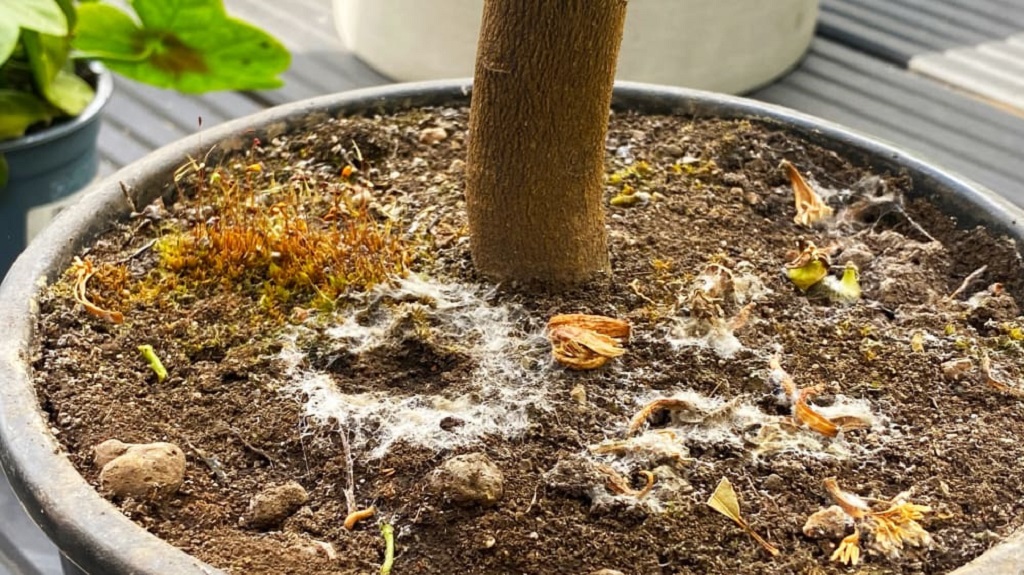
If you’re a gardener or a homeowner who loves keeping plants, you might have noticed some white fuzz growing on the top of your soil. This phenomenon is commonly known as “mycelium,” a fungus that grows on decomposing plant material. This white fuzz is a sign of healthy soil and a good indicator that your plants thrive. Mycelium is essential for plant growth as it plays a crucial role in breaking down organic matter in the soil, making it easier for plants to absorb nutrients. Additionally, mycelium helps to maintain soil moisture and improve soil structure, making it more aerated and allowing plants to grow deeper roots. So, if you see this white fuzz on soil, don’t worry; it’s not harmful. It’s a sign that your garden is thriving and healthy!
What Causes White Fuzz on Soil?

The white fuzz on top of the soil is usually caused by mycelium, the vegetative part of a fungus. Mycelium grows as tiny threadlike filaments called hyphae that branch through the soil. As these filaments grow and spread, they can form a dense, cottony white layer on the soil surface.
There are a few different types of beneficial fungi that can create this fuzzy layer:
- Actinobacteria are essential in decomposing organic material and releasing nutrients into the soil. The mycelium appears as a white powdery or web-like coating.
- Mycorrhizal fungi form a symbiotic relationship with plant roots, improving nutrient and water uptake. The surface mycelium is bright white and fluffy.
- Saprophytic fungi – These fungi break down dead or decaying matter. The mycelium looks dry and felt above ground.
So, in most cases, the white fuzz comes from helpful fungi in healthy soil ecosystems.
Why Is It Good for Your Garden?
The fungi that cause the white fuzz are providing some great benefits for your plants and soil:
Nutrient cycling – The fungi release enzymes that break down organic matter and turn it into plant-available nutrients. This mineralizes nitrogen, phosphorus, and other nutrients from the soil.
Water retention – The threadlike hyphae help bind soil particles together, improving soil structure. This allows the soil to retain more moisture.
Root support – Mycorrhizal fungi have an incredibly close relationship with plant roots. The fungi receive sugars from the plant while assisting the roots with accessing nutrients and water.
Suppressing pathogens – Beneficial fungi help crowd out and compete with disease-causing fungi and other harmful microbes. Their presence enhances the overall soil microbial balance.
So, while the fuzz might look a little odd, it indicates good soil life. The fungi are complex at work, supporting plant and soil health.
Is White Fuzz on Soil Ever Bad?
White fuzzy mold on your soil is usually standard and helpful. However, occasionally, it can be a sign of a harmful fungal issue:
- Gray mold – Also called Botrytis cinerea, gray mold thrives in wet conditions and can attack seeds, seedlings, and plant tissues. It appears as a fuzzy gray or brown mold.
- Powdery mildew – This disease flourishes in humid air and causes a fine white coating on leaves and stems. It can spread spores to the soil surface as well.
- Root rot fungi – Overly moist soil can lead to root-rotting fungi like Fusarium, Phytophthora, and Pythium species. These cause roots and lower stems to turn soft and brown.
So, if you notice brown, dying plants in conjunction with surface fuzz, it may be a pathogenic fungus at work. Proper drainage and drying out overly wet soil should help remedy the issue.
How to Get Rid of Harmful Fungi
If you suspect harmful fungi are causing issues in your garden, there are a few treatment options:
- Improve airflow and drainage to reduce excess moisture, supporting fungal growth.
- Gently rake up and discard any affected plant debris and a top layer of soil that may contain fungal spores.
- Apply a fungicide drench to infected plants following label instructions. Organic options contain bacteria (Bacillus subtilis) or neem oil.
- Solarize the soil by wetting it, covering it with plastic, and leaving it in the hot sun for several weeks to kill fungi and spores.
- Rotate plant families in growing areas to prevent disease buildup. Avoid replanting susceptible species.
- Mix in organic compost, which contains beneficial microbes that can outcompete pathogens.
Harmful outbreaks of fungal diseases can often be avoided with extra care to promote soil drying and microbial diversity.
Encouraging Beneficial Fungi
Rather than getting rid of all soil fungi, aim to promote the helpful kinds through innovative gardening practices:
- Add organic matter like compost, manure, or leaf litter regularly to feed beneficial fungi.
- Reduce soil disturbance and tillage, which damages delicate fungal networks.
- Plant cover crops and avoid leaving soil bare, which assists fungal colonization.
- Rotate different plant families and avoid replanting the same area repeatedly.
- Improve drainage in overly moist areas but avoid completely drying out soil.
- Reduce chemical fertilizer and pesticide use, which harms fungi and other soil life.
With some care to enhance soil health, the fungi will thrive and keep doing their underground jobs to support your garden plants!
When to Worry About White Fuzz on Houseplants

Indoor houseplants can also develop white fuzz on their potting mix. This is typically harmless mycelium from saprophytic fungi that help break down organic matter in the soil. However, indoor humidity can also encourage the growth of gray mold or powdery mildew. Carefully inspect leaves and stems for signs of disease and adjust watering to avoid overly damp soil. Increase air circulation around plants. You can also report plants in a fresh sterile potting mix to clean up mold issues.
FAQ About White Fuzz on Soil
Is white mold on soil dangerous?
In most cases, the white fuzz on soil is harmless mycelium from beneficial fungi. But gray mold, powdery mildew, and root rot fungi can also cause white mold and damage plants. Carefully inspect for signs of disease.
Should I remove white fungus from the soil?
Avoid removing beneficial white fungal mycelium, which helps soil health. Only drag and replace infected soil if plants show signs of fungal disease like moldy leaves, stems, or roots.
How do you treat white fungi in soil?
Improve drainage, gently remove infected material, apply organic fungicides, solarize soil, and incorporate compost to treat harmful white fungi in garden beds. Rotate plantings and encourage beneficial fungi.
What does white mycelium in soil look like?
The vegetative body of helpful soil fungi creates cottony white mycelium, a web-like matrix of threadlike hyphae that spreads through the soil and creates a fuzzy layer on the surface. It looks a bit like mold but is harmless.
Is white mycelium excellent or bad?
White fungal mycelium growing on your soil is very beneficial in most cases. It decomposes organic matter, retains moisture, supports plant roots, and crowds out pathogens. Only remove mycelium if plants show signs of fungal disease.
Conclusion
More often than not, seeing white fuzz or mold on the surface of your garden or houseplant soil is a good sign. This white mycelium comes from beneficial saprophytic, mycorrhizal, and actinobacterial fungi that decompose organic matter, recycle nutrients, improve cure, Explore A Guide to Magical Solar Garden Décor and support supports. Harmful fungal diseases like gray mold, powdery mildew, and root rot can occasionally cause issues, but proper watering and cultivation practices help favor healthy fungi instead. With a bit of diligence, you can harness the help of microscopic soil fungi to grow thriving plants!





